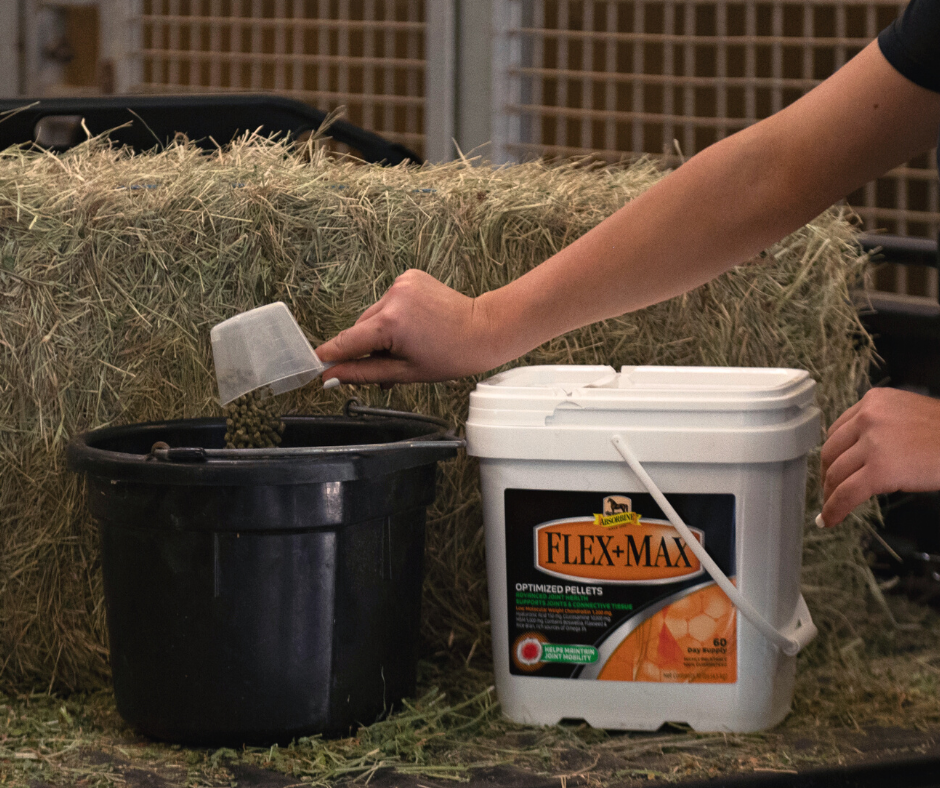As a horse owner, you’ve likely wondered, “Does my horse need a joint supplement?” Perhaps your trail horse feels a little stiff going down hills these days. Maybe your show campaigner isn’t changing leads with the same finesse. Or if you have a young horse, you’re probably interested in keeping his joints healthy for as long as possible.
When your knee hurts, it’s no fun to exercise. The same is true for horses. Joint pain can decrease not only their performance, but their quality of life. Regardless of their activity or age, joint supplements can help your horse move and feel their best.
Joint problems in horses
Joints are complex structures made up of ligaments, tendons, muscle, cartilage and bones. When healthy, all these components work seamlessly to bear weight and support movement. When any part of the joint is unhealthy—due to degeneration, injury or disease—movement becomes restricted and painful. Eventually, joint pain can even become debilitating.
Studies show that more than 60 percent of all equine lameness can be attributed to arthritis, a term that simply means joint inflammation. And while we often consider joint inflammation to be the purview of aged athletes, horses of all ages, disciplines and activity levels can be afflicted.
Does my horse have joint pain?
If your horse is moving or acting differently than normal, it’s time to consult your veterinarian and investigate joint pain as a possible cause.
Often, joint pain becomes apparent when the horse’s performance decreases. They might move stiffly, rush transitions, become short-strided or have difficulty holding leads. Sometimes, joint pain manifests in a horse’s behavior; they develop a sour attitude, pinning their ears or grinding their teeth at rider aids. For horses not in work, you might notice they’re lying down more and frolicking less.
Unfortunately, by the time a horse is showing symptoms, the joint has already been affected. Early intervention is critical in stopping the cycle of damage and helping your horse live comfortably with joint changes. Even better than early intervention? Prevent or delay joint issues by optimizing joint health from an early age.

How do I choose the correct joint supplement for my horse?
1. Buy a joint supplement from a reputable company.
Not all joint supplements are created equal. When selecting a joint supplement, one thing you might want to look for is a seal from the National Animal Supplement Council (NASC). This seal identifies products from companies that are committed to the highest standards of quality and continuous improvement to promote the well-being of companion animals and horses. It’s a way for consumers to know that when they buy a supplement, they are buying from a reputable company.
2. Look for quality ingredients.
These high-quality ingredients can significantly improve your horse’s mobility and longevity by reducing inflammation and supporting healthy joint structures. Look for the following ingredients when shopping for a joint supplement:
- Glucosamine: One of the most widely researched joint support ingredients, glucosamine slows cartilage deterioration and reduces pain.
- Low Molecular Weight Chondroitin: Chondroitin works with glucosamine to protect cells called chondrocytes, which help support cartilage structure. It also decreases swelling by destroying harmful enzymes in joints. Low molecular weight chondroitin is five times smaller than standard chondroitin, which greatly improves intestinal absorption.
- MSM: Methylsulfonylmethane (MSM) is a naturally occurring form of sulfur that minimizes inflammation and maintains healthy connective tissue, cartilage, bones and hooves.
- Hyaluronic Acid: Hyaluronic acid reduces inflammation, promotes cartilage and bone growth, hydrates tissue and encourages joint lubrication.
- Boswellia serrata: Though a relative newcomer to Western medicine, studies suggest this herb is effective at decreasing inflammation and supporting joint cartilage.
- Flaxseed and rice bran: The Omega-3 and -6 fatty acids in flaxseed and rice bran reduce inflammation and increase the elasticity of connective tissue.
Are joint supplements a waste of money?

Absolutely not! While supplements can’t cure arthritis or other joint-related problems (arthritis is an incurable degeneration), both research and anecdotal evidence have shown that supplements improve mobility, range of motion and performance in horses with joint issues.
To ensure you aren’t throwing away money, it’s important to buy a joint supplement with effective, highly bioavailable ingredients. With premium joint supplements like Flex+Max®, results are guaranteed, and the supplement’s high-quality ingredients mean you can feed less—just a single daily scoop—getting more bang for your buck.
When is the best time to start my horse on a joint supplement program?
As soon as possible. The best time to start your horse on a joint supplement is before your horse starts showing signs of pain. By supporting healthy joints before a problem arises, you’ll help prevent their degeneration. But even if your horse has already started showing signs of discomfort, joint supplements can help.
Before instituting any changes in diet or health management, consult your veterinarian.








